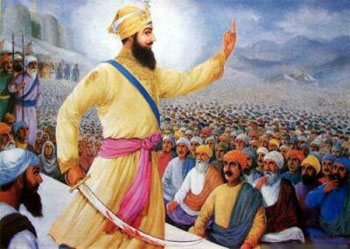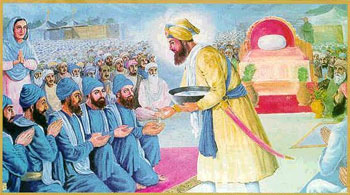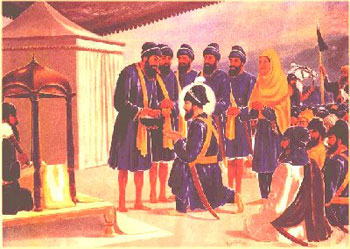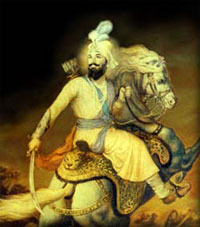The Khalsa - Origin & brief History

At Sri Anandpur Sahib Ji, Guru Gobind Singh Ji chose the first day of the solar month of Baisakh that fell on April 13th 1699. The beginning of the month of Baisakh symbolises renewal and regeneration, ripening and fruition. Earlier, it was on this day that Gautam realised enlightenment and became the Buddha, heralding a new era in Indian civilisation qualitatively different from the prevalent Hindu civilisation and culture. Guru Gobind Singh Ji purposely chose this day for ushering in a new dawn, a new chapter in world history, a new phase of world civilisation, envisioned by the first Prophet of Sikhism, Guru Nanak. The Guru had asked the faith-followers from all over India to assemble at Sri Anandpur Sahib Ji on the chosen day. The huge congregation became mysteriously innervated when the Guru with a divine glow in his eyes and a naked sword in his hand, gave a thundering call for a devout Sikh to come forward to offer his head then and there for the sake of dharma. Guru Gobind Singh Ji was putting to test his followers readiness for sacrifice of life - a sacrifice of the mundane life sibilated into the Life Divine. Guru Nanak himself had laid down the test:

"If you seek to play (the game) of Love, then, enter upon the Path with your head upon your palm"
At the third call of the Guru, according to the tradition, Daya Ram (a Khatri by caste) from Lahore (now in Pakistan) arose to offer his head to the Guru who took him into an adjoining enclosure. At the subsequent calls of the Guru, came forward Dharam Dass (a Jat) from Delhi in northern India, Mohkam Chand (a washer man) from Dwarika in Gujrat; Himmat Rai (a cook from Jheevar Caste) belonging to Jagan Nath Puri in Orissa in eastern India, and Sahib Chand (a low caste barber) from Bidar in southern India; they were also taken into the enclosure. The five self-sacrificing Sikhs had undergone a sacramental 'passage', a death-like experience for their celestial vision of and interface with the Spirit-Destroyer and Creator at the same time.
Clad in new yellow garments with blue turbans, radiating dynamism and determination, they were brought back before the congregation that burst into resounding words of Sat Sri Akal (immortal and ever present is the time-transcendent Spirit). The Guru Ji, then, amidst recitation of the Divine Word, embodied in the sacred hymns, stirred, with a double-edged sword, the water, in a steel vessel, sweetened by sugar plums, and thus prepared the Baptismal nectar (amrit) - the elixir of courage and compassion - that was administered to the five Sikhs who came to be known as the Beloved Five (Punj Pyare).
They, with appellation of 'Singh' added to their names, became the first five initiates of the order of the Khalsa created by the Guru through the sacramental nectar. Guru Gobind Rai Ji became Guru Gobind Singh Ji when he got baptised by the Beloved Five. The act of the Guru seeking baptism from his baptised followers, apart from revealing the democratic ethos of Sikhism shows that God, the Guru and the follower become one in spirit; the moment of baptismal transformation becomes the moment of trans-animation. This was a sacrament of resurrection, of spiritual ascent of man. The extravagant event at Sri Anandpur Sahib Ji also pointed to the process of descent of the God in time. The spiritual ascent of man and the historical descent of the spirit, in a sense, mark, under the generic category of the Khalsa, the evolution of sovereign man in direct communion and unison with the Divine Sovereign (Waheguru Ji Ka Khalsa).
At the third call of the Guru, according to the tradition, Daya Ram (a Khatri by caste) from Lahore (now in Pakistan) arose to offer his head to the Guru who took him into an adjoining enclosure. At the subsequent calls of the Guru, came forward Dharam Dass (a Jat) from Delhi in northern India, Mohkam Chand (a washer man) from Dwarika in Gujrat; Himmat Rai (a cook from Jheevar Caste) belonging to Jagan Nath Puri in Orissa in eastern India, and Sahib Chand (a low caste barber) from Bidar in southern India; they were also taken into the enclosure. The five self-sacrificing Sikhs had undergone a sacramental 'passage', a death-like experience for their celestial vision of and interface with the Spirit-Destroyer and Creator at the same time.
Clad in new yellow garments with blue turbans, radiating dynamism and determination, they were brought back before the congregation that burst into resounding words of Sat Sri Akal (immortal and ever present is the time-transcendent Spirit). The Guru Ji, then, amidst recitation of the Divine Word, embodied in the sacred hymns, stirred, with a double-edged sword, the water, in a steel vessel, sweetened by sugar plums, and thus prepared the Baptismal nectar (amrit) - the elixir of courage and compassion - that was administered to the five Sikhs who came to be known as the Beloved Five (Punj Pyare).
They, with appellation of 'Singh' added to their names, became the first five initiates of the order of the Khalsa created by the Guru through the sacramental nectar. Guru Gobind Rai Ji became Guru Gobind Singh Ji when he got baptised by the Beloved Five. The act of the Guru seeking baptism from his baptised followers, apart from revealing the democratic ethos of Sikhism shows that God, the Guru and the follower become one in spirit; the moment of baptismal transformation becomes the moment of trans-animation. This was a sacrament of resurrection, of spiritual ascent of man. The extravagant event at Sri Anandpur Sahib Ji also pointed to the process of descent of the God in time. The spiritual ascent of man and the historical descent of the spirit, in a sense, mark, under the generic category of the Khalsa, the evolution of sovereign man in direct communion and unison with the Divine Sovereign (Waheguru Ji Ka Khalsa).

Once Guru Gobind Singh Ji publicly baptised the five beloved ones, who had offered their lives expecting to be executed. They all took the name "Singh" (lion) and were blessed with the five K's: Kesh (uncut hair), Kanga (Comb), Kirpan (Dagger sword), Kara (Steel bracelet), Kachhera (Shorts). Women were named Kaur (princess, lioness).
Kesh - uncut hair and beard, as given by God, to sustain him or her in higher consciousness; and a turban, the crown of spirituality.
Kangha - a wooden comb to properly groom the hair as a symbol of cleanliness.
Kirpan - the sword, with which the Khalsa is committed to righteously defend the fine line of the Truth
Kara - a steel circle, worn on the wrist, signifying bondage to Truth and freedom from every other entanglement.
Kachhera - specially made cotton underwear as a reminder of the commitment to purity
Guru Gobind Singh Ji, then exemplified the Sikh ideal of the Soldier-Saint. "When all other means have failed," he said, "only then is it righteous to take up the sword."
Kesh - uncut hair and beard, as given by God, to sustain him or her in higher consciousness; and a turban, the crown of spirituality.
Kangha - a wooden comb to properly groom the hair as a symbol of cleanliness.
Kirpan - the sword, with which the Khalsa is committed to righteously defend the fine line of the Truth
Kara - a steel circle, worn on the wrist, signifying bondage to Truth and freedom from every other entanglement.
Kachhera - specially made cotton underwear as a reminder of the commitment to purity
Guru Gobind Singh Ji, then exemplified the Sikh ideal of the Soldier-Saint. "When all other means have failed," he said, "only then is it righteous to take up the sword."


Guru Gobind Singh Ji was the last Guru of the Sikhs in human form. He had created the Khalsa, a spiritual brotherhood and sisterhood devoted to purity of thought and action. He gave the Khalsa a distinctive external form to remind them of their commitment, and to help them maintain an elevated state of consciousness. Every Sikh baptised as Khalsa vows to wear the Five "K's":
Khalsa was also vowed to refrain from any sexual relationships outside of marriage, to refrain from cutting hair, taking meat, tobacco, alcohol, and all other intoxicants.
Then Guru Gobind Singh Ji infused his own being into the Khalsa, declaring that the Khalsa was now the Guru in all-temporal matters. For spiritual matters, the Guruship was given to the "Siri Guru Granth Sahib Ji", a compilation of sacred writings by those who have experienced Truth. For Sikhs, "Siri Guru Granth Sahib Ji" is the living embodiment of the Guru, and is regarded with the utmost reverence and respect wherever it is found. Sikhs all over the world took to the "Siri Guru Granth Sahib Ji" as their living Guru, as the source of spiritual instruction and guidance.
Khalsa was also vowed to refrain from any sexual relationships outside of marriage, to refrain from cutting hair, taking meat, tobacco, alcohol, and all other intoxicants.
Then Guru Gobind Singh Ji infused his own being into the Khalsa, declaring that the Khalsa was now the Guru in all-temporal matters. For spiritual matters, the Guruship was given to the "Siri Guru Granth Sahib Ji", a compilation of sacred writings by those who have experienced Truth. For Sikhs, "Siri Guru Granth Sahib Ji" is the living embodiment of the Guru, and is regarded with the utmost reverence and respect wherever it is found. Sikhs all over the world took to the "Siri Guru Granth Sahib Ji" as their living Guru, as the source of spiritual instruction and guidance.
